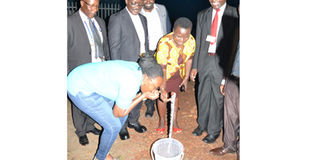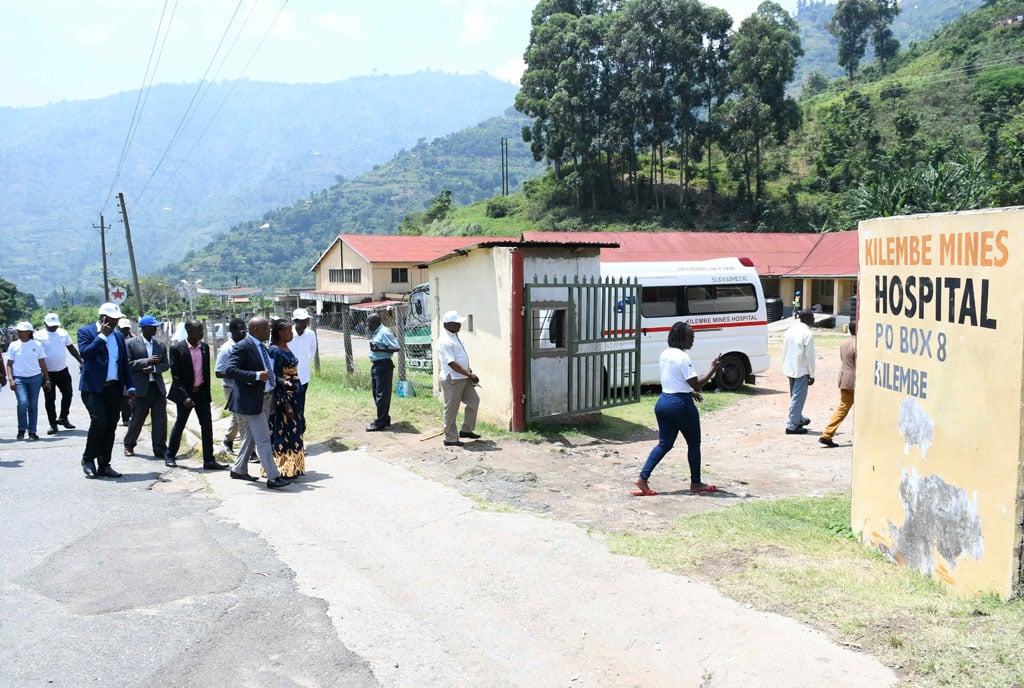8,000 households get piped water

Luweero Resident District Commissioner Phoebe Namulindwa (in blue) tastes tap water as district leaders and National Water and Sewerage Corporation managing director Silver Mugisha (3rd left) look on in Luweero District on Saturday. PHOTO BY DAN WANDERA
About 8,000 households in seven villages of Butuntumula Sub-County in Luweero District have a reason to smile after government extended piped water.
The villages include Lukiizi, Kayonza, Kyegombwa, Nakakono, Kabanyi, Ngogolo and Kakinzi.
Ms Amina Nagawa, a resident of Lukiizi Village, said there is a water dam at Lukiizi that serves more than 200 households but it is shared with animals.
Residents say this has compromised their health, whereas the long distances have caused domestic violence when the women delay.
“The piped water connection project is a miracle for our village. We have been burdened by livestock farmers who deliberately take their respective animals at the dam yet the dam user committee had put up barriers to restrict animals from contaminating the water source.
“The water is not only made muddy, but it is contaminated by the animal waste,” Ms Nagawa, who works as a village health team member, said in an interview on Monday.
The project, according to the district authorities, was meant to benefit the urban and semi-urban communities of Luweero.
However, the poor bedrock surface which made it difficult to have boreholes in villages, forced the district to redirect the funds towards accessing piped water.
“We have been fighting the water problem in many of those areas where all the boreholes get dry just a few weeks after commissioning because the surface bed rock is poor.
“We resolved to allocate Shs60m in partnership with National Water and Sewerage Corporation (NWSC) to have piped water. We believe this option could help resolve the access to safe water coverage and minimise problems,” Mr Ronald Ndawula, the Luweero District chairperson and also secretary for works, said.
He said the district has been spending a lot of money on repairing boreholes.
“We discussed with the residents about the piped water project that is cheaper since they only have to pay Shs50 per 20 litre jerrycan at the public stand pipes. This is a much cheaper water source than the dirty dam water,” Mr Ndawula added.
Mr Ronald Kisakye, the NWSC manager of Luweero, said NWSC originally targeted piped water distribution to the urban and semi-urban areas in more than 200 towns.
“We are yet to build the capacity to distribute the piped water to all areas in Uganda. For Luweero District, the mentioned villages are lucky that the district has allocated some funds... We have already engaged the communities and sensitised them on how they can use the water profitably for both production and development,” Mr Kisakye said.
Previously, clean piped water was only accessible by 27.5 per cent of the population in Luweero, but limited to Luweero Town, Wobulenzi, Bombo, Zirobwe, Kikyusa and Bamunanika.
In Butuntumula Sub-county, residents depend on water from dams which are more than 6kms away.
Mr John Paul Kibalama, the Butuntumula Sub-county chairperson, says the piped water project is a timely intervention for his area.
Part of Greater Luweero area which comprises the districts of Luweero, Nakasongola and Nakaseke is located in the cattle corridor, which usually suffers water shortage whenever there are long dry spells.
Statistics from the district water office indicate that about 76 per cent of the total population depend on point water sources which include protected water springs, boreholes and shallow wells while majority of the population within the cattle corridor sub-counties, which include Butuntumula, Kikyusa, and Kamira, depend on water stored at different water dams which they share with livestock.
Statistics
In 2018, NWSC revealed they were looking for Shs15b to extend piped water to more 406 villages in the urban areas of Luweero, Wobulenzi, Semuto, Bombo, Kapeeka and Zirobwe which fall under the Luweero water cluster that covers a distance of 531km.
Currently, NWSC manages water in 258 towns and rural growth centres across Uganda.
According to NWSC plan, another 10,609 villages and 7.7 million people will be added to the piped water grid to allow them have access to safe water by the end of 2020.




